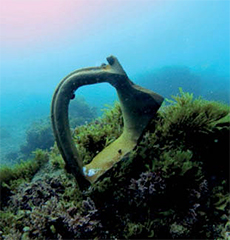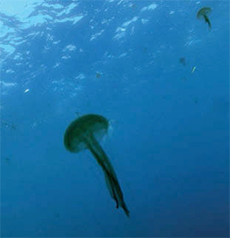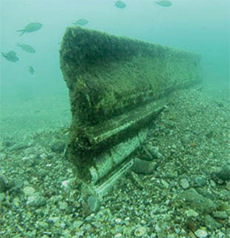




| Home | Features | Club Nights | Underwater Pics | Feedback | Non-Celebrity Diver | Events | 12 July 2025 |
| Blog | Archive | Medical FAQs | Competitions | Travel Offers | The Crew | Contact Us | MDC | LDC |

|

|
 
 |
   ISSUE 19 ARCHIVE - UNDERWATER ARCHAEOLOGYJuliette ClaroSo apart from capuccinos a gogo, lemoncillos, and the Camorra what has Naples got to offer?Hmm... the best pizzas in the world you might say, yes indeed, but most of all Naples is a niche for underwater archaeology master classes giving you the excitement to actually dig for Roman remains yourself underwater (much more exhilarating than Herculaneum and Pompei which have already been dug out for you and are full of Japanese tourists... booooring!). 45 minute train journey West of Naples will take you to Pozzuoli, a charming little town sitting in the Campi Flegrei region of Naples where the Greeks settled their first colonies in Italy in 730BC. In the region of Cumae the Greeks funded a fortified city which flourished through marine trade. Later, Pozzuoli was elected as a prime port by the Roman Emperor Augustus, which helped enable the region to become a city of splendour with beautiful landscapes. Additionally the primary advantage of having volcanic activities in the area attracted wealthy Romans to build impressive villas and bathhouses around the town. The Romans loved Pozzuoli for its thermal attributes and the town became the Santa Barbara of the Roman ‘Jet Set' during the late republican period Baiae. After the fall of the Roman Empire the area began to lose its appeal and eventually the villas, the thermal baths and the port were abandoned in favour of Naples. In 1538, the birth of the mount Monte Nuovo happened as a result of bradyseism (for scrabble players: it is the result of the ground sinking and lifting in a region of volcanic activity) which caused a change of the sea level and submerged parts of the region. Just a stone throw away from Pompei and Herculaneum, the Underwater Archeology Park of Baiae was instituted as a marine protected area in 2002 by the Italian Ministry for Environment. It is a significant protected marine environment which is strictly regulated for its historical, archaeological and cultural values. The park is divided into three zones A, B and C which regulate the marine activities in the area. To access the dive sites you must be guided by an accredited centre. The easiest and friendliest is Centro Sub Campi Flegrei, which is actually located on the beach and has direct access to the sites from their jetty. Centro Sub Campi Flegrei offers PADI and CMAS courses and provides a full historical and archaeological briefing of the dive sites which will give you the feeling of being Indiana Jones, exploring on sacred land! The club also has full rental equipment if you can't afford the rather expensive Easyjet luggage fees (remember your hand luggage must be 58cm x41cm... you may need to fly with your wet suit on...) There are around ten dive sites in the park of Baiae and all of them include the tasks of digging, brushing, and searching for mosaics, marble floors and pottery. It is absolutely fascinating to hover above Roman baths, Roman roads, columns and ancient walls. Buoyancy control is a must here! All sites are around 5–6m depth. The experience is more powerful than Pompei and Herculaneum in the sense that you are yourself looking for the remains, and once it is in front of you, you can't help letting go a deep “WAOW” in your regulator... the statues at the sunken Claudius Nymphaeum create a eery atmosphere as you move along the submerged building. Slightly further away, the dive site at Villa Protiro offers the most stunning black and white mosaics and the floor plan of a Roman villa with an atrium in the centre which allows the light to come through the house. It is truly Pompei under water! The Smokey Reef site, by its name, shows active fumaroles from the volcanic activity underground. The smokes coming off the columns deposit sulphur which covers the sea bed. The area is rich in sea life and shows the remains of the columns protecting Port Julius. Entry to the Archeological Park of Baiae is regulated and by diving with Centro Sub Campi Flegrei entrance of the park is included in the dive package. The dive centre will happily organise accommodation nearby in their affiliated hotels in Pozzuoli. Useful website: centrosubcampiflegrei.it Pozzuoli: Linea 2 Napoli Metropolitan Train from Garibaldi Station – 2.80 one way. The Bay of Naples and its islands of Capri, Ischia and Procida are a delight for getting a taste of the la dolce vita... Limoncellos, fresh juices, pizzas, pasta, olives, cappuccinos and... a lot of spirited Italians! Driving around the bay and the islands is an experience in itself, especially on a rental scooter! You may wish to decide to escape by train or ferry instead. And what a wise choice! Within an hour by train on the East of Naples, Sorrento will bring you the thrill of deep dives in the protected peninsula of Punta Campanella. Again, a zone of strictly protected marine environments and a national program of research and environmental consulting to develop eco-sustainable solutions for the territory facing heavy fishing and dredging of red coral for the jewellery industry. Diving Punta Campanella makes you rethink the stereotype of the Mediterranean as the sea of the living dead. It is full of life which demonstrates that protected marine environment do work. Here you can see colonies of red coral at less than 50m, groupers, cuttlefish, barracudas, lobsters (yes! You read it! LOBSTERS!), and groups of pelagic fish and turtles in the areas away from the coast. For a great and thrilling experience contact Sorrento Diving Futuro Mare, situated on the Marina Piccola of Sorrento. They will talk to you through the scientific research program and they will also guide you through the protected marine zone. www.sorrentodiving.it Sorrento is on the Circumvesuviana line – 4.10 from Naples Garibaldi Station. Capri, Ischia and Procida are easily reached by ferry from Naples. The islands are normally day-tripper havens, so it's recommended to allow a stopover to really appreciate their charm of these islands. Capri is to Naples what Notting Hill is to London. It is the favourite destination for wealthy Italians but also it is a favourite for Americans and Japanese tourists. But don't worry, they usually only crowd the island for the day. After 6pm when the last ferry leaves the island you can plan your dives in peace over a limoncello in front of a stunning sunset overlooking the deep blue sea. Capri has a breathtaking limestone landscape with cliffs and caves which you can dive at the discretion of your tour guide. Capri, Ischia and Procida have drop off walls where colonies of red and black corals can be seen below 40m (see attached article on red coral protection). Ischia has also a protected marine area “Regno di Nettuno” which prevents dredging and extensive fishing around the island. Useful websites: www.caprisub.com / www.onischia.com So to sum up, the Bay of Naples has a lot to offer with a variety of dive sites which surpasses expectations in the Mediterranean Sea. Best time to visit is in May, June or September avoiding the heat and the mass holiday makers in July and August. From archaeological diving to deep diving with groupers, the Bay of Naples will mesmerise you under water as much as on land so make the most of the low cost flights this summer and enjoy the delights of Napoli but remember one thing: if UK diving is ruled by the weather, Naples diving is ruled by...football! When Napoli football teams plays... all diving is cancelled. Better go when the football season is over then! Ciao a tutti! |